Poodles are one of the most beloved dog breeds out there. Beloved for their fancy looks and hypoallergenic coats, dog owners worldwide are proud to call these fluffballs their companions.
But did you know that they come in different sizes? That’s right! According to the American Kennel Club, there are Toy Poodles, Miniature Poodles, and Standard Poodles. There are also some sizes that aren’t part of the AKC, but we won’t get into that right now.
They all have their distinct ranges of height and weight, and we are here today to talk about the largest type of Poodle and to give you the ultimate Standard Poodle growth chart!
By reading this article, you will learn how big and heavy a Standard Poodle breed dog gets during its life, what factors impact its growth, and all the details about its different stages of development.
We will also answer some of the questions related to possible weight-related health issues, so make sure you stick around until the end.
Standard Poodle Growth Chart
| Age | Male Standard Poodle Weight | Female Standard Poodle Weight |
|---|---|---|
| 1 month | 5 to 9 pounds (2.3 to 4.1 kg) | 4 to 7 pounds (1.8 to 3.2 kg) |
| 2 months | 16 to 20 pounds (7.3 to 9.1 kg) | 11 to 16 pounds (5 to 7.3 kg) |
| 3 months | 22 to 26 pounds (10 to 11.8 kg) | 20 to 24 pounds (9.1 to 10.9 kg) |
| 4 months | 30 to 35 pounds (13.6 to 15.9 kg) | 24 to 28 pounds (10.9 to 12.7 kg) |
| 5 months | 35 to 41 pounds (15.9 to 18.6 kg) | 26 to 30 pounds (11.8 to 13.6 kg) |
| 6 months | 41 to 48 pounds (18.6 to 21.8 kg) | 28 to 34 pounds (12.7 to 15.4 kg) |
| 7 months | 48 to 55 pounds (21.8 to 24.9 kg) | 30 to 36 pounds (13.6 to 16.3 kg) |
| 8 months | 50 to 57 pounds (22.7 to 25.9 kg) | 32 to 38 pounds (14.5 to 17.2 kg) |
| 9 months | 52 to 61 pounds (23.6 to 27.7 kg) | 34 to 40 pounds (15.4 to 18.1 kg) |
| 10 months | 55 to 63 pounds (24.9 to 28.6 kg) | 36 to 44 pounds (16.3 to 20 kg) |
| 11 months | 57 to 68 pounds (25.9 to 30.8 kg) | 38 to 46 pounds (17.2 to 20.9 kg) |
| 12 months | 60 to 70 pounds (27.2 to 31.8 kg) | 40 to 50 pounds (18.1 to 22.7 kg) |
| 2 years (fully grown) | 60 to 70 pounds (27.2 to 31.8 kg) | 40 to 50 pounds (18.1 to 22.7 kg) |
| Age | Male Standard Poodle Height | Female Standard Poodle Height |
|---|---|---|
| 1 month | 8 to 10 inches (20.3 to 25.4 cm) | 8 to 10 inches (20.3 to 25.4 cm) |
| 2 months | 12 to 13 inches (30.5 to 33 cm) | 10 to 12 inches (25.4 to 30.5 cm) |
| 3 months | 14 to 15 inches (35.6 to 38.1 cm) | 12 to 14 inches (30.5 to 35.6 cm) |
| 4 months | 18 to 19 inches (45.7 to 48.3 cm) | 16 to 18 inches (40.3 to 45.7 cm) |
| 6 months | 18 to 22 inches (45.7 to 55.9 cm) | 18 to 22 inches (45.7 to 55.9 cm) |
| 12 months | 18 to 24 inches (45.7 to 61 cm) | 18 to 24 inches (45.7 to 61 cm) |
| 2 years (fully grown) | 18 to 24 inches (45.7 to 61 cm) | 18 to 24 inches (45.7 to 61 cm) |
How Big Will My Standard Poodle Get?
Adult Standard Poodles typically grow to be at least 18 inches and at most 24 inches tall. This range is pretty similar for both males and females, although female Standard Poodles will not reach the maximum 24 inches so often.
When it comes to weight, fully mature male Standard Poodles weigh between 60 and 70 pounds, while females are significantly lighter, around 40 to 50 pounds. Anything above these values can be considered overweight, and anything less is underweight.
Looking at these numbers, we can conclude that female Standard Poodles generally have a slenderer frame, with less muscle weight on them.
When Will My Standard Poodle Stop Growing?
Most Standard Poodles will reach their full adult size and stop growing around the age of eighteen months. There is no rule that is set in stone and every dog is individually different, but a year and a half is usually the average.
Obviously, they can continue to add weight after this point, but that is not recommended if they have already reached the 60 to 70 lb range, for males, or the 40 to 50 lb range, for females.
Why Do You Need A Standard Poodle Growth Chart?
Keeping track of a puppy’s growth and especially its weight during the formative months of its life is one of the most important aspects of dog parenting.
With our Standard Poodle growth chart, you will be able to stay on top of your Poodle’s growth and make sure that it’s on the right track. By checking the chart regularly and comparing the numbers to your pup’s actual size, you can notice any potential irregularities in its development.
If your puppy constantly seems to be below the recommended size and weight, that might be a symptom of a health condition or perhaps a sign that you should modify its diet. Conversely, if it’s bigger than it’s supposed to be — i.e., if it’s trending toward being overweight — you can nip this in the bud by adapting the nutrition and amping up the exercise.
But there are more advantages to having a handy Standard Poodle growth chart than just that. By knowing exactly how big and heavy your dog is supposed to be at all ages, you have a great foundation that you can use to plan its diet and set aside a budget.
Poodles aren’t exactly big eaters, but they still require a healthy diet of quality food, especially if they are spending a lot of energy on their daily activities.
Raising a dog can be quite expensive at times, so anything that can help you approximate your budget more accurately and save money on any unnecessary costs is a great tool.
Standard Poodle Developmental Stages
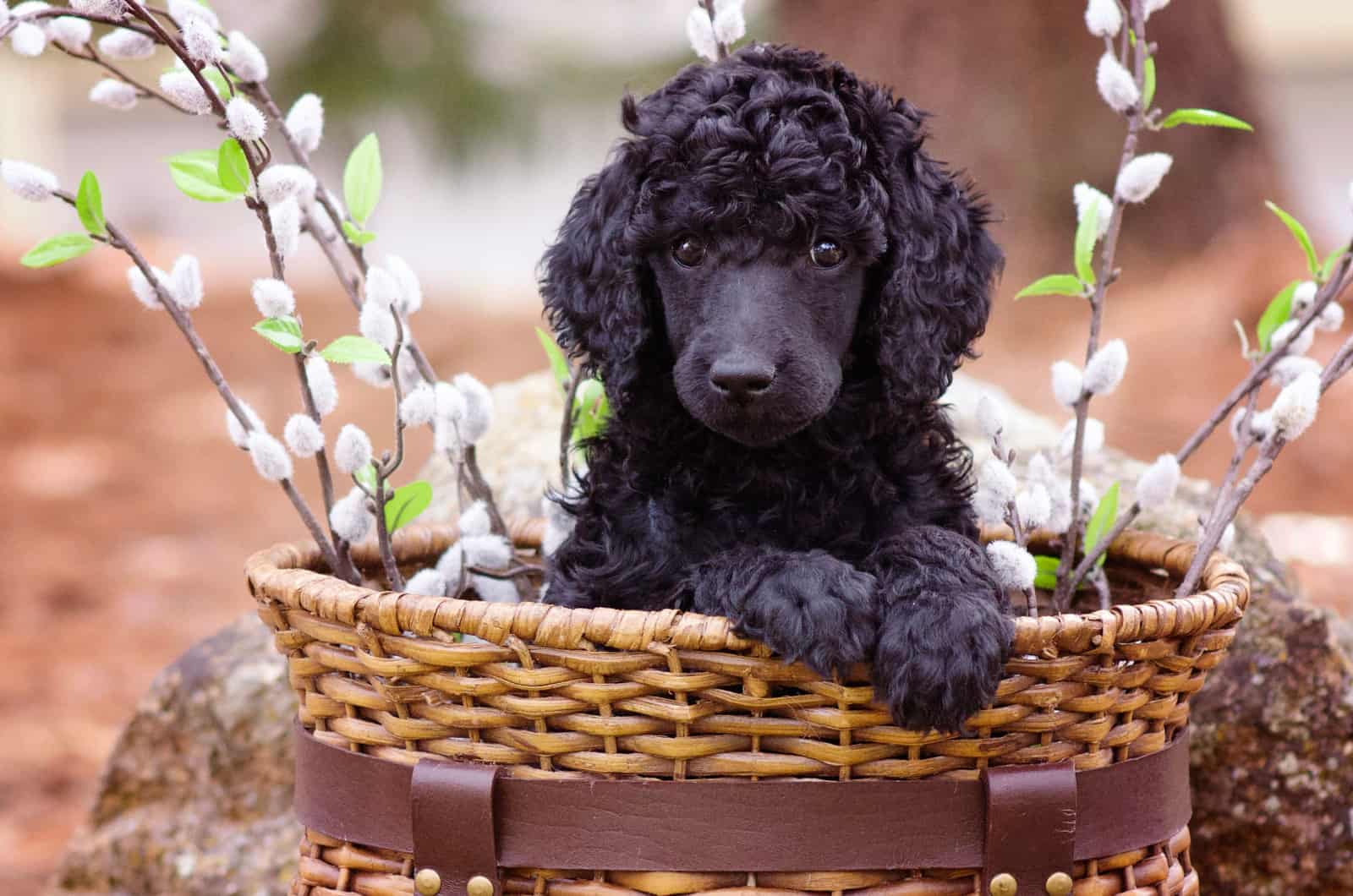
The Standard Poodle growth chart above is great when you want a quick glance at the expected dog weight range, just to check if your dog is where it should be. But what if you want more information than that?
Well, don’t worry, we’ve thought of that, as well. We wanted to give you a detailed insight into what actually goes on in a Poodle’s body and how it develops during certain key periods of its puppyhood.
In broad terms, the first eighteen months to two years can be divided into five different stages. Each of those stages carries different milestones in a puppy’s development, both physically and mentally.
Of course, each puppy is different, so the individual timelines will vary, but this still represents a great reference point for any dog owner that wants to have some context for their pup’s growth.
So let us now dig into each of those five stages and explain what exactly your dog is going through.
From Birth To Two Weeks Old: Neonatal Period
Newborn Standard Poodles are tiny balls of fur, weighing no more than a couple of ounces. However, as soon as they start drinking their mother’s milk and receiving all the necessary nutrients, their growth rate increases rapidly.
They spend their days either feeding or sleeping, so everything they take in is put towards their growth and development. Typically, they gain a pound or so of weight during each of these weeks.
From Two Weeks To Four Weeks Old: Transitional Period
We call this stage of a Poodle’s development the transitional period because this is usually the time when they are weaned off their mother’s milk and encouraged to try some solid puppy food.
That is one significant lifestyle change that happens during this short period, and the other one is that they start moving around on their own for the first time. Their eyes and ears have fully opened, their bodies have grown to about five pounds, and they are slowly beginning to take in the world around them.
This means that they are now expending more energy than before, which is exactly why the switch to solid food is important. It provides them with those extra calories and nutrients that they simply can’t get from mommy.
Some people even opt to introduce them to a raw food diet. That might be more associated with large dogs, but Standard Poodles can be raw-fed, too. You just need to be very careful about choosing the right amounts.
They are usually still very timid and attached to their mom, but it is a sign of things to come.
From Four Weeks To Three Months Old: Socialization Period
Physical development continues at an accelerated pace throughout this period. Standard Poodles usually reach the numbers of 14 inches in height and 25 pounds in weight by the time they are three months old.
This continuous growth spurt is accompanied by bone growth and strengthening. Poodles’ bones and joints will grow and become sturdier, which is absolutely necessary in order to keep up with all the added weight.
But the development of their bodies is just one aspect of the growth that happens during this stage. After all, there is a reason why we have called it the socialization period.
Now fully accustomed to their ability to hear and see, Standard Poodle puppies learn how to use those senses to make new friends. They will explore their surroundings in a wider circle than ever before and reach out to any animal or human that they run into.
They start developing their first relationships outside of their mother and siblings, and they are most likely already picking their favorite human. Hint: it’s probably the one that feeds them and plays with them the most.
This period is key in Poodle pup’s mental development, as it’s the best possible time to start slowly training them and teaching them to follow instructions. They are sometimes prone to being aggressive, and socialization is more difficult for such dogs.
However, if you begin laying the groundwork in these early months, you should have a well-behaved dog by the time its first birthday comes along.
Another important thing to mention is that this period is usually when Standard Poodles will receive their first dose of vaccinations.
From Three Months To Six Months Old: Testing Period
In the middle of this period, the growth rate of Standard Poodle puppies will finally slow down and plateau at around 18 inches. One of the reasons for a lower growth rate is their energy is being expended elsewhere.
You see, six-month-old Standard Poodle puppies will already have some confidence and they will be exploring more than ever before. The level of their physical activity will greatly increase, and you will need to be able to keep up.
You will have to provide enough opportunity for them to explore their physicality, but you will also probably have to have a lot of patience and discipline. Poodles are generally a curious and active dog breed, and they can sometimes try to test the boundaries that you have set.
You will have to make sure that you don’t leave them unattended for long periods of time.
From Six Months To Eighteen Months Old: Period Of Adolescence
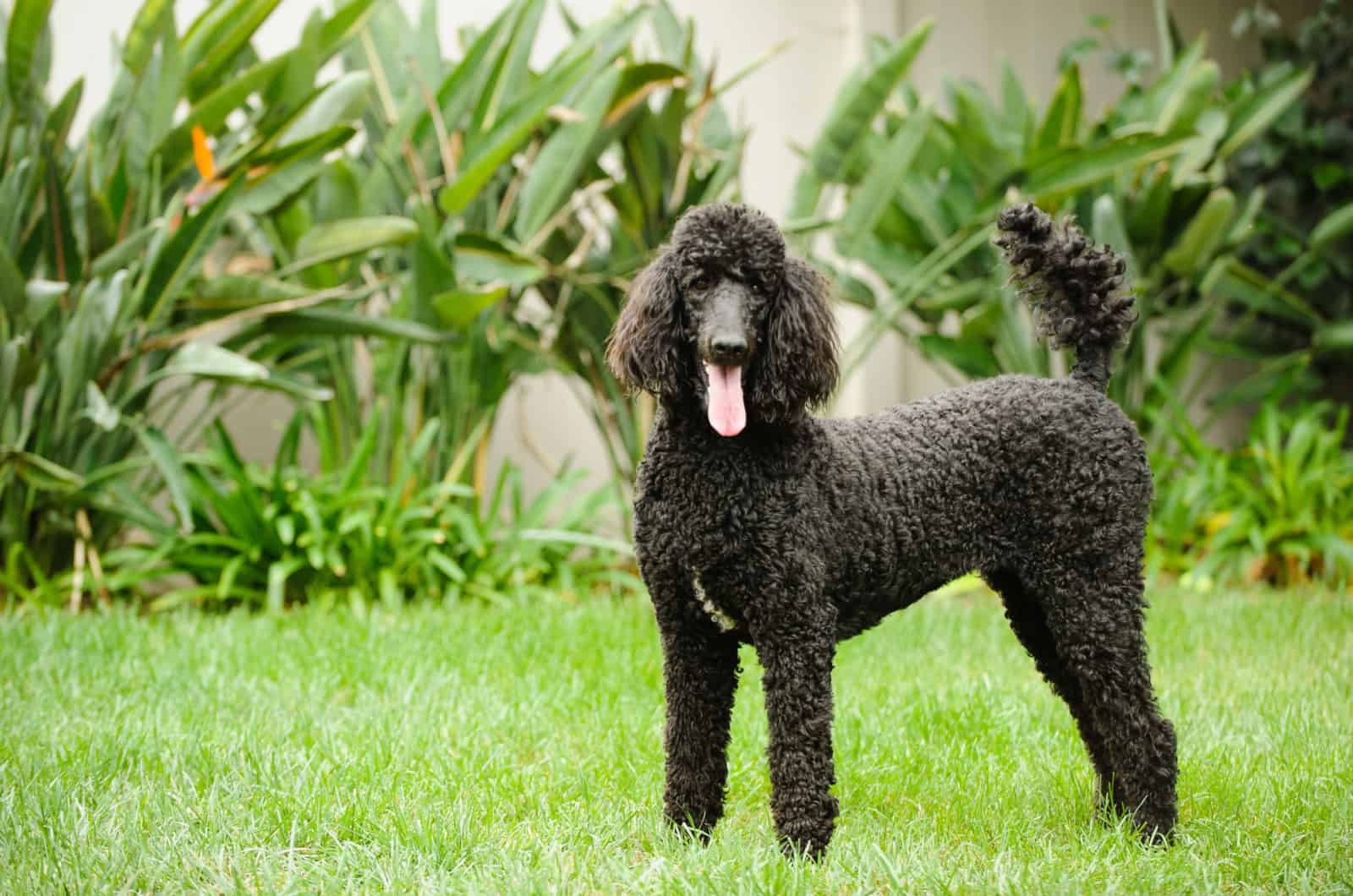
Much like with humans, adolescence is the stage in which a Poodle experiences a lot of changes in its hormone levels. Those changes manifest themselves in many different ways.
For example, they will experience one final big growth spurt which can lead to them gaining another 15 to 20 pounds and quickly approaching their full adult weight.
The changes to their height won’t be as substantial, but they will typically grow a couple of inches at the withers, which will bring them up to around 20 inches in total. That is around their average adult height and most Poodles don’t grow much beyond that.
Another way that the hormonal changes manifest themselves is that the difference between males and females becomes clearer and more visible than ever. Aside from the fully formed reproductive organs and females entering their first heat cycle, the difference in size becomes readily apparent, so it becomes pretty easy to distinguish between the two genders.
Just take a look at the growth chart at the top of the article and compare the heights and weights of males and females at this age. The difference is obvious.
This is one of the reasons that make this age the ideal time for spaying and neutering. If you choose to fix your Poodles, you will probably need to do it in this span of time, but as always, make sure to consult your vet.
After Eighteen Months Of Age: Adult Dog
The year-and-a-half mark is usually the point at which Standard Poodles have fully matured, both physically and mentally.
Once they reach this age, what you see is what you get, basically for the rest of their lives. Their skeleton has reached full strength, their muscles are completely fleshed out, and their personality is more or less set.
The only physical growth of any meaning that happens after this point is weight gain. And you need to be careful with weight gain because it can be especially dangerous in small dogs. We’ll talk about potential issues later on, but the most important thing is that you keep an eye on your Poodle’s pounds and make sure they’re within the average range.
That’s what the weight chart is for!
Factors That Impact Standard Poodle Size And Weight
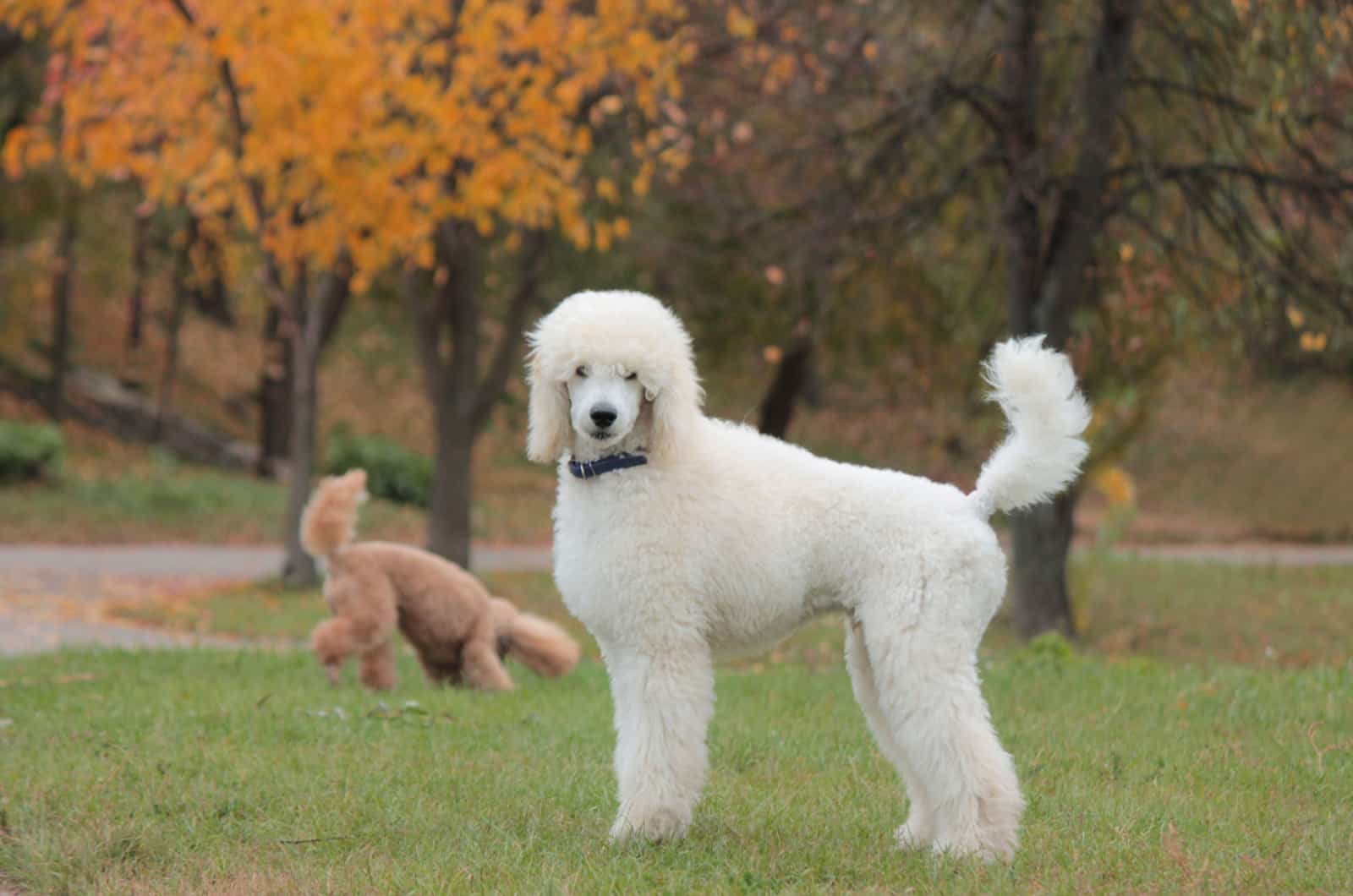
Why are some dogs big, and others small? Why are there three different sizes of Poodles? Those are both valid questions, and the answer to both is the same: there are multiple reasons.
There is never just one thing that determines a dog’s size and weight because that would be too easy. There are a multitude of factors, both internal and external, that all come together. Knowing what those factors are and how they influence your Standard Poodle’s weight, in particular, can be extremely helpful in keeping it fit and healthy.
Internal Factors
Internal factors are those that a dog is born with and are usually out of your control. You can’t really change anything about a dog’s genetics or gender, but just by knowing those facts in advance, you can prepare for what’s to come and make sure that the puppy experiences the best possible conditions for its development.
Genetics
Nearly all physical traits in dogs are inherited from their parents, who have inherited them from their parents, etc. After a few generations, this becomes a rich tapestry of genes that can be hard to decipher and predict.
Luckily, most reputable breeders keep detailed records of their puppies’ ancestry, which is a massive help if you want to learn more about your future pet. When it comes to size, things are usually simpler to predict than with coat colors, for example.
If you breed two fairly big Poodles, chances are that their offspring will also be above average in size. The same thing goes for breeding two small Poodles. And if you breed a large dog with a small one, the puppies will be around the average of the two, with possible differences from one individual puppy to another.
With Poodles, breeders will usually stick to the size categories and only breed two dogs that are of similar sizes. Two Standard Poodles bred with each other will most likely result in a litter of Standard Poodles.
Gender
As we’ve already mentioned, when we were talking about the adolescent period of Standard Poodles, there are noticeable differences in size and weight between male and female Poodles.
Males are significantly bigger, going up to 24 inches and 70 pounds, while females usually only get to 22-23 inches and 50 pounds.
However, there are special circumstances that can change this, and they are mostly related to spaying and neutering. We’ll talk about the influence that fixing your Poodle has on its growth, but it’s probably pretty obvious that a female that has been through pregnancy will be a bit heavier than the one that hasn’t.
External Factors
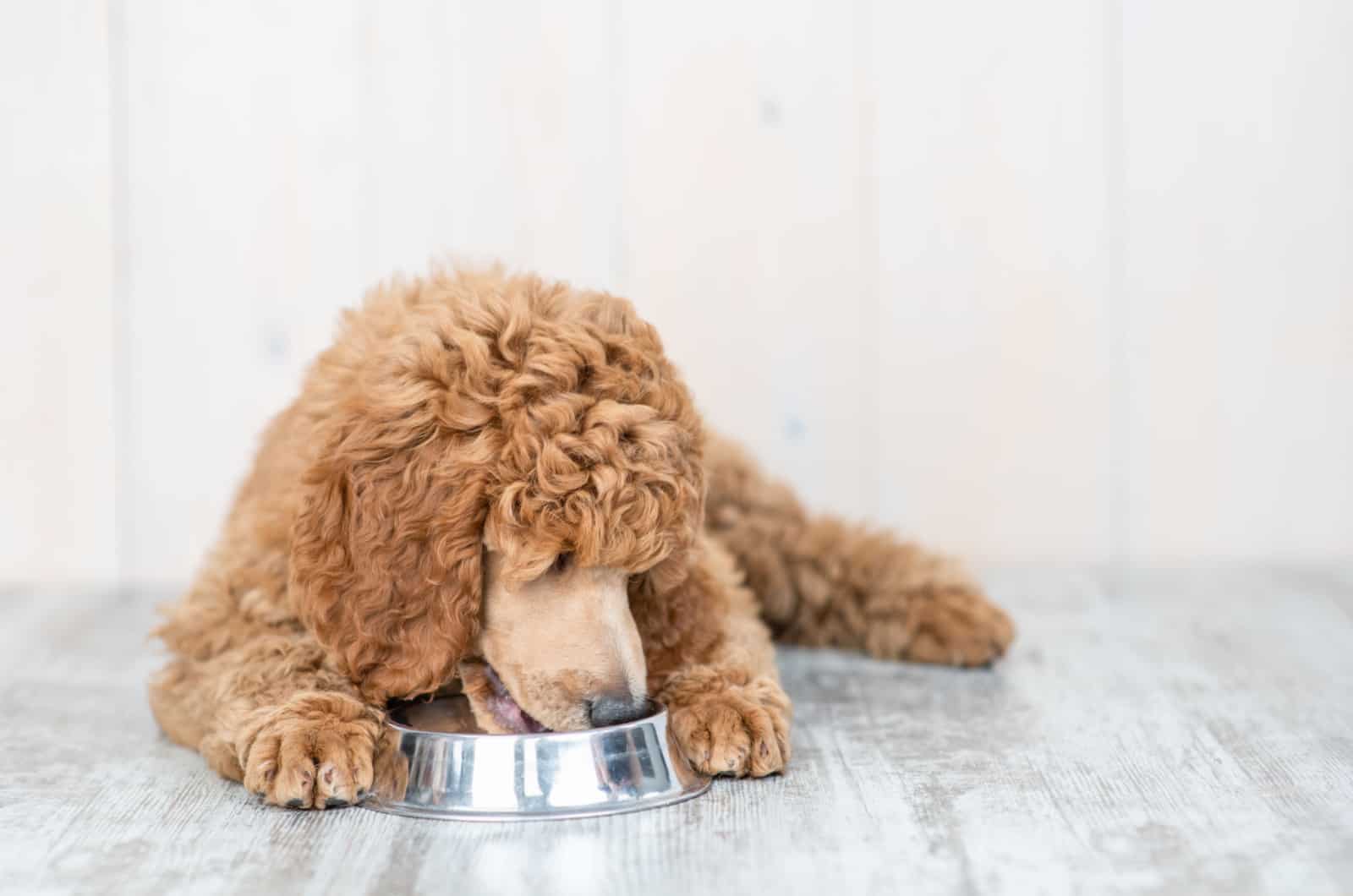
External factors that shape a Standard Poodles’ growth are usually associated with its nutrition and physical activity.
Those are the two main tools that you can use to control your pup’s weight and keep it within healthy bounds. Let’s get deeper into the actual impact they have and how you can use them for your dog’s benefit.
Diet
The growth of a Standard Poodle should be a continuous, steady process that lasts for 18 months. Growing either too quickly or too slowly is usually a sign of an imbalance, and most often it’s in the puppy’s nutrition.
Your Standard Poodle needs a balanced, regulated diet that will provide it with all the ingredients that are needed for its development, in all the right amounts. The amounts change over time — a six-week-old puppy will not eat as much dog food as a one-year old — the principle remains the same.
There is a middle ground to be reached between feeding your puppy too little and too much, and in order to get there, you need to make some well-informed decisions and provide it with proper nutrition. Reach out to experts, consult your vet, and maybe even read our feeding chart.
Exercise
Exercise is the counterbalance to feeding. Regular physical activity and stimulation will help your Poodle expend all the calories that it doesn’t need for its growth or metabolism. This way, the dog stays lean and fit, with minimal risk of becoming overweight.
Standard Poodles are highly energetic and active dogs, so you should provide them with ample opportunity to channel that energy. Let them loose in your yard, take them for a walk as often as you can, and think of other ways you can keep them entertained and stimulated on a day-to-day basis.
The Impact of Spaying/Neutering On Standard Poodle Growth
As we’ve already teased earlier in the article, now we’re going to talk about the impact of spaying and neutering on the growth of a Standard Poodle.
Fixing your dog not only removes its reproductive organs, but it also cuts off the supply of various hormones that stimulate and support growth, especially during the first year of its life.
Doing it too early can cause your Standard Poodle to grow at an uneven and unpredictable rate, and it can even lead to various bone and joint issues. It’s advised to wait with neutering or spaying your Standard Poodle until they are around twelve months of age, as it becomes a much safer procedure after that point.
If performed at the right time, spaying/neutering can be beneficial in many ways, including reducing the risk of cancer. In any case, it’s always important to seek an expert opinion before making the decision, because once you do it, there is no going back.
Possible Health Issues Related To Weight
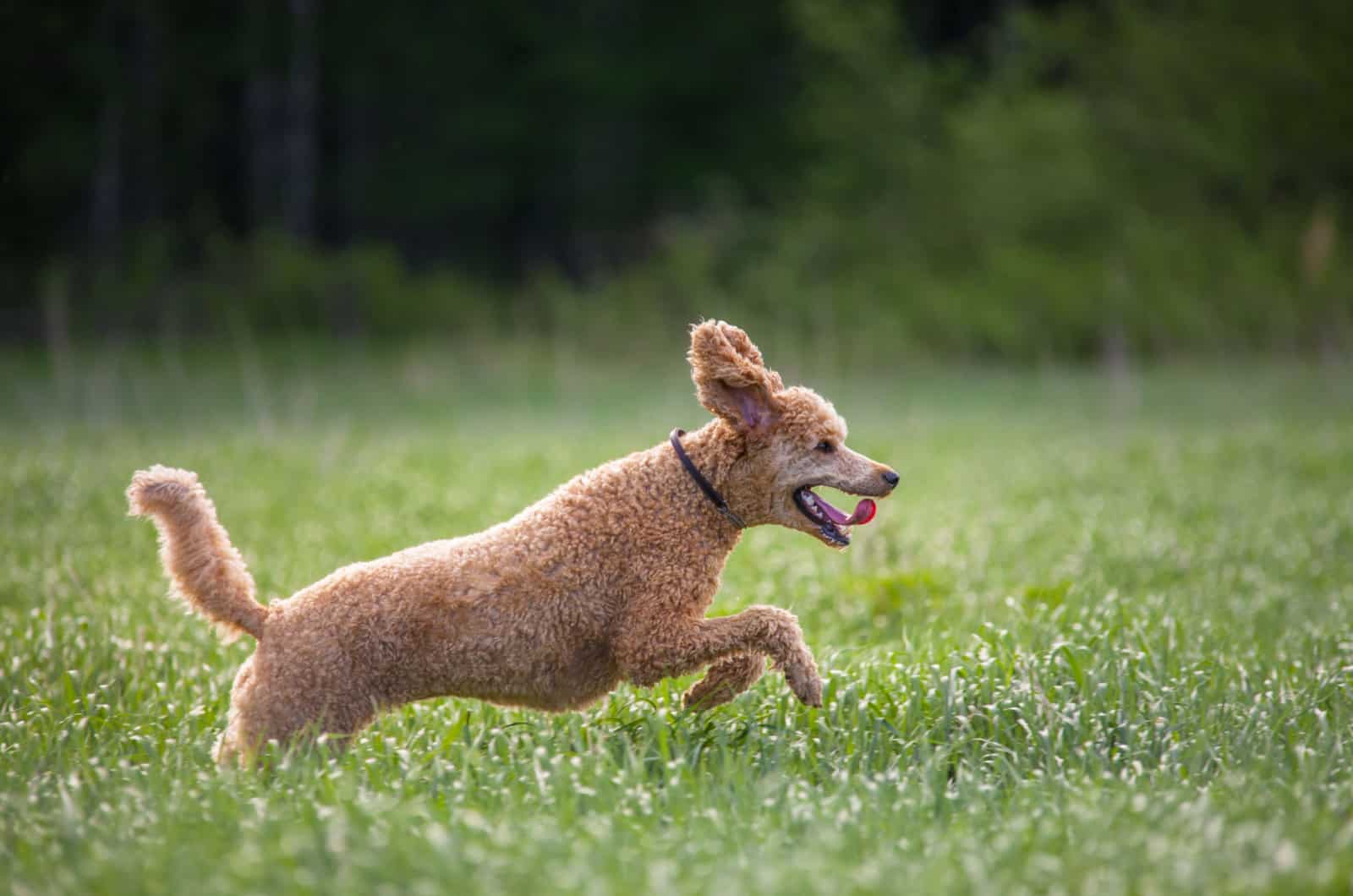
If you’ve been going to the gym and adhering to a special diet for months, and then you suddenly choose to stop all that and start munching on some greasy hamburgers, you will quickly realize how easy it is to gain weight.
It’s not that different with dogs, but unlike us, they don’t really have the self-discipline to keep their own weight in check. And I’m pretty sure they aren’t allowed in the gym, either.
However, they have their owners whose responsibility it is to maintain their weight at a healthy level for them. It is a commitment that lasts a lifetime and being extra careful about it can ensure a long and healthy life for your favorite furball.
Can Standard Poodles Be Overweight?
Standard Poodles are a highly active dog breed, to say the least. Anybody who has ever had one of these cuties will know how difficult it can be to keep up with them when they get the zoomies.
Because of that high activity level, they are not usually prone to weight gain and obesity. This issue is more often associated with large breed dogs, such as Retrievers and German Shepherds.
The only ways it can happen for a Standard Poodle is if they are fed way too much, or if they don’t exercise enough. That can sometimes be a problem with Poodle owners who live in an apartment where they don’t have easy access to a yard.
However, if you notice that your Standard Poodle has put on a few extra pounds, you can take matters into your own hands and help them shed it. Decrease their daily food intake by 20-25%, cut off treats completely for a while, or increase the amount and intensity of exercise.
Can Standard Poodles Be Underweight?
Being underweight is a much more common problem for Standard Poodles than being overweight. All of that running around combined with their lightning-fast metabolism can result in your Poodle shedding pounds more quickly than it can add them.
One way that you can combat this is by modifying their diet. Try increasing their daily food intake by 20-25% or mixing in some fatty wet food with their kibble. Too much fat is not a good thing. but in appropriate amounts, it can act as a great energy reserve, which can be vital for a Poodle.
If you choose to increase your Standard Poodle’s food intake, make sure to only do it until it gets back to an acceptable weight. After that, get them back on the standard diet that is designed to maintain their weight.
If your Poodle is not gaining weight despite increased portions, or if it’s refusing to eat, please contact your vet and ask them for a check-up, as it might be a sign of a health issue.
How Do I Know If My Standard Poodle Is Overweight Or Underweight?
Well, it’s easy — just take a look at Pupvine’s Standard Poodle growth chart!
But if you don’t have a scale nearby and you need to check whether your Standard Poodle is within the correct weight range, there is a way to do it. The key is in the ribs.
Take a look at your Poodle’s underside. If its ribs are clearly visible, that means that your dog is underweight and needs to be put on a weight-gaining regime. If the ribs aren’t visible, but you feel them under your fingers when you rub your hand across the area, that signifies that the dog has a healthy weight.
However, if you rub your hand across the area and don’t feel the dog’s ribs under your fingers, it’s because it’s overweight.
Other Health Problems In Standard Poodles
While we are on the topic of health, it would be remiss not to mention some of the more common health problems that affect Standard Poodles.
Generally speaking, Standard Poodles are a healthy breed with a long lifespan, but that doesn’t mean they are immune to illness. Some of the issues that they most frequently face are hip dysplasia, bloat, epilepsy, and Addison’s disease.
Final Thoughts
Having a Standard Poodle growth chart at hand is a no-brainer if you are a Standard Poodle owner. It’s an incredibly simple but effective tool that can bring you many benefits as you take care of your dog’s growth and development.
You can use it to track your Poodle’s growth and check if it’s in the desired height and weight range at any time simply by cross-referencing the chart with your dog’s actual weight. Looking at it from a long-term perspective, it gives you room to plan your Poodle’s diet weeks and months in advance.
Furthermore, it can even help you take better care of your Poodle’s health. Being underweight or overweight can sometimes be the first visible sign of a dog that is developing a health condition and noticing it on time can be vital in the battle against it.
If you want to be a Standard Poodle owner, and you happen to be from Ontario, Canada, we have a great list of the nine best breeders in that region.













